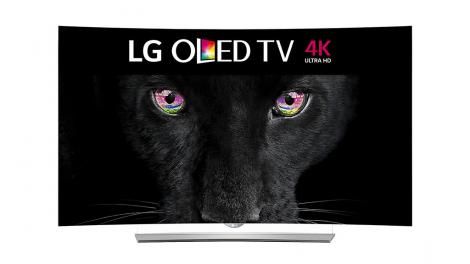
Introduction and features
When it comes to televisions, there’s no finer technology currently available than that of the Organic Light Emitting Diode.
We’ve all heard the hype about incredible contrast ratios and unsurpassed brightness – but does the fancy-schmancy OLED acronym really improve the television watching experience?
And, more importantly, does it justify the added cost? Add to that the other hyped-about TV tech of the moment, 4K (or Ultra HD), as well as a slightly curved display, and you’ve got yourself a whole bunch of home cinema buzzwords of the moment – all of which can be used to describe LG’s jaw-dropping EG960T series of televisions.
Having spent some time with the 65-inch model, we can honestly say that this is one awesome slab of next-gen tech. As the only television manufacturer currently on the Australian market that can boast both 4K resolutions and OLED technology in its displays at the same time, LG has reached the top-tier of display tech for the here and now.
With that said, with top-of-the-range specs comes top-of-the-range prices – the 65-inch 65EG960T model will set you back $9,999 while the 55-inch 55EG960T model is priced at $5,999.
One of the things that you’ll likely notice right away about LG’s 4K OLED is just how remarkably slim it is. It has a depth of around 5mm, with a bulge lower down the centre of the TV’s chassis on the rear. You don’t have to worry about that, though – it’s not exactly chunky, and it’s kept away from interfering from the slinky sides.
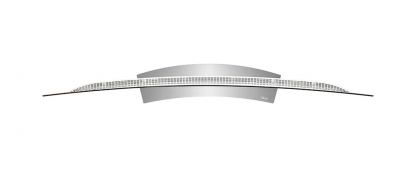
This belter is also curved or contoured – call it what you will – though it’s not as severe a feature as it might look.
While the curved vs flat display debate has raged ever since the introduction of the first concave HDTV, the argument is unlikely to get people riled up with regards to the EG960T – its curve is much more subtle than all of the other curved displays we’ve seen, which lets the set immerse you in the action, without being distracting.
Features
What is this 65-incher’s standout feature? It certainly has a few to choose from. You could pick the OLED panel, the curved design or the Ultra HD 4K screen resolution of 3840×2160 on their own and still take the cake from the majority of sets on the market.
Add them all together, and you have a force to be reckoned with. Its user interface is an updated version of webOS (2.0), which is noticeably faster than before, allowing you to browse Netflix and YouTube for stunning 4K content. You’ll likely be spending a lot of time in those two apps until 4K content becomes readily available elsewhere.
The EG960T doesn’t come in a non-curved model, which is a bit of a shame since not everyone is entirely convinced of the added immersion benefits that these displays provide, though the curve is at least more subtle here than it is on competing sets – you can even wall-mount the EG960T without it looking weird. The addition of a filter also helps cut down on annoying reflections seen on other curved screens.
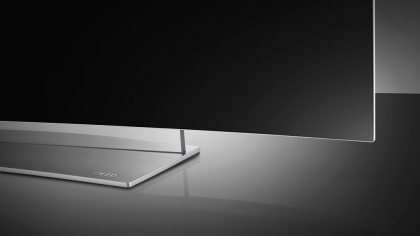
Its audio is taken care of by an Ultra Surround Sound module by Harman Kardon, which is quite loud, if not particularly bassy or impactful. If you’re going to go all out by picking up the most advanced TV on the market, you’re likely going to want a proper 7.1 TrueHD or Dolby Atmos setup to go along with it.
As well as Freeview HD digital tuners, WiFi and Harman Kardon speakers, the EG960T is 3D-ready, too, and comes with four pairs of the same passive 3D glasses given out at your local multiplex.
However, if forced to choose the feature that stands above the rest, we’d have to go with its OLED panel. It sports LG’s four-colour Pixel WRGB technology, which adds a white subpixel to the usual red, green and blue mix.
Unlike LED and LCD displays, OLED doesn’t require a backlight, letting the set’s self-lighting pixels do the heavy lifting. Because of this, individual pixels turn off completely during dark scenes, allowing for true blackness on the display.
This isn’t that ‘almost black’ that standard TVs usually get away with, where you can still see that the screen is on – OLED makes your TV look like it’s completely switched off during black scenes.
This ‘perfect black’ makes the bright colours that shine out of the darkness stand out even more, offering unprecedented detail that’s made possible due to the EG960T’s infinite contrast ratio.
Yes, you read that right: this television doesn’t offer a ten trillion-to-one contrast ratio – its self-lighting pixels make the display’s contrast ratio literally infinite.
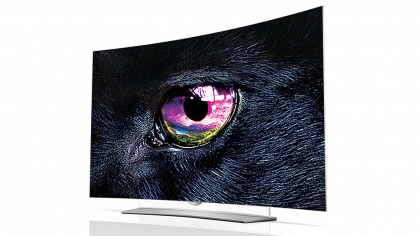
The lack of a backlight means that the EG960T’s viewing angles are quite extraordinary. While it’s not ideal to view a curved television from the side (another reason why flat screens will always be preferable), you’ll be glad to know that there’s no backlight leakage to be found on this set, allowing it to maintain exceptional colour, clarity and brightness when viewed from any angle.
Usability
Ins & outs
Just three HDMI 2.0 inputs on the EG960T is a slight cause for concern though elsewhere there are no such shortages.
Joining that trio on an outwards facing side-panel are three USB slots, a headphones jack and a Common Interface slot, while below are feeds for the TV tuners, a Scart, a component/composite video adaptor, an optical digital audio output and an Ethernet LAN slot.
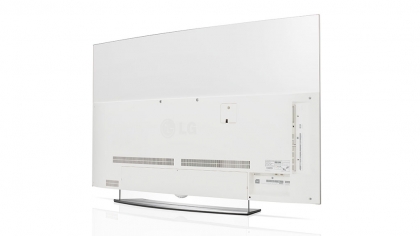
Usability
The EG960T uses LG’s Magic Remote, a Wii remote-style pointer that lets you pick options on the screen rather than navigate through they with your remote’s directional pad. The TV’s interface is built around this kind of control method, so while you can just use the D-pad to get around, it doesn’t feel as natural as just pointing at stuff and pressing ‘OK’.
The main pop-up taskbar is a carousel of colourful tabs that starts on the left with a pile of screen-grabs from the live input or current live app that can be flicked through.
This is how you reach Netflix, YouTube, ABC iView, SBS On Demand and other Web OS 2.0 apps. There’s also a My Programmes tab that, when pressed, expands to show the last eight TV channels you watched.
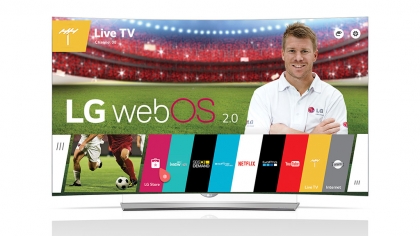
Click a right-hand tab and it brings up smaller icons for all of those apps plus a few of the TVs internal options, such as live TV, a connected Blu-ray player, LG’s Content Store, or whatever you’ve recently been watching.
You can also use the pointer to switch between content sources. This brings us to one of the TV’s only notable faults – we found on a couple of occasions that the TV would get stuck when trying to switch between content sources or apps.
We’d point and click at the Netflix or Blu-ray player tab, and nothing would happen. Turning the TV off and on again fixed the problem immediately (thanks, IT Crowd), though it was a slight annoyance. It’s not a deal-breaker, though – the issue is sure to be addressed in a future firmware update.

Performance
Performance
It’s been said that Marvel’s Daredevil series on Netflix was shot in a way that could only be viewed as originally envisioned on a 4K OLED TV. The series’ director of photography, Matt Lloyd, has stated that his creative team shot scenes that were “irresponsibly dark”, and that he was able to film things differently because of OLED screens.
Naturally, we took this as an opportunity to go straight to the show-stopping, single-shot hallway fight scene from the second episode of Daredevil, booted up in the EG960T’s Cinema mode, as recommended by TV’s accompanying paperwork, and, in this case, the show’s cinematographer.
Immediately, the scene’s dank and dingy hallway is rendered with complete clarity, with dark areas and shadows disappearing gradually into complete blackness.
Daredevil walks into the frame, dressed head-to-toe in black, his dark-side appearing like a silhouette against a grimy green and (off)white wall. Meanwhile, the light on his back gives a good indication of how naturally the pixels fade from light to dark.
This is due to LG’s 10-bit colour depth, producing over a billion colours and providing spectacular shading that eliminates that weird wavy effect that sometimes emanates from light sources on LED/LCD televisions.
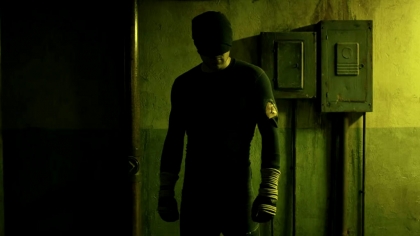
As mentioned earlier, clarity is absolutely exceptional. Watching the show in its native 4K resolution (thanks to the TV’s Netflix app), there was not a single instance of aliasing present.
Picture quality is to die for – bright primary colours of red and blue rip through inky black backgrounds, displaying in exquisite detail. If colour is convincing across the spectrum, so is the response time; even frenetic movement is silky smooth, and we didn’t notice any motion blur or sped-up framerate spiking.
Occasionally, Netflix would drop down to 1080p during high-traffic periods (through no fault of the TV itself) and it still looked great, benefitting greatly from the OLED’s perfect black technology and 6-step upscaling capabilities.
Which brings us to the performance of 1080p Blu-ray and video game content on the EG960T. We opted to test a range of Blu-ray discs or varying quality on the television, as well as Wii-U and PlayStation 4 consoles.
We began with Gravity. There was a fade-to-black moment mid-way through the film – the room didn’t just darken, it disappeared. Every single pixel switched off and left no residual trace of any light. It was incredibly impressive, to say the least.
How can a TV go completely dead, and for such a brief moment? What’s more, when a bright, white object is shown in the centre of the screen, the background is so black that it appears to stretch far beyond the edges of the screen itself, almost as if the entire room becomes the backdrop.
On the EG960T, light is produced by passing electricity through a thin layer of carbon-based organic dyes at a pixel level, not at a backlight level as with LED. LG also has its own take on OLED tech, producing a white pixel as well as the usual red, green and blue.
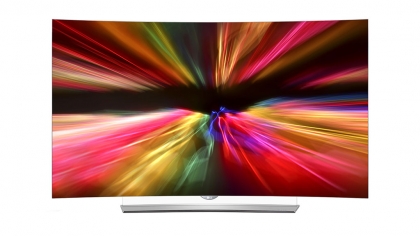
Gravity on 2D Blu-ray puts those insane black levels to good use, providing a completely convincing and involving night sky dotted with white, bright stars. Likewise, a Blu-ray viewing of Interstellar showed us the remarkable depths of space in a way we hadn’t experienced since the film’s initial IMAX presentation.
The film’s wormhole scene provided us with a view of what seemed like a limitless supply of stars. Whenever the film cut to a full-frame IMAX shot, which is often, you’d have no way of knowing that what you’re watching isn’t 4K.
Quite frankly, we didn’t even think this kind of detail was possible on a regular Blu-ray disc. That’s either thanks to the TV’s OLED technology tapping into the format’s full potential, or some seriously great upscaling.
We also checked out Lawrence of Arabia on Blu-ray, in an effort to see how an older film (50+ years) would look (albeit, one remastered from a 4K scan), and the results were also impressive. With that said, picture quality was not quite as mind-blowing as something like Interstellar, which was shot on modern film stock and digitally processed. The TV’s upscaling efforts were a little more evident here.
The same can be said about our turn playing the Wii-U game, Mario Kart 8. While the game itself is incredibly vibrant, silky smooth and known for being one of Nintendo’s more visually impressive efforts, when viewed on a 4K television, the (admittedly older) Wii-U hardware’s limitations became more evident.
That’s not to say that it looked bad, far from it, but it’s clear that the system wasn’t designed to look fantastic on a 65-inch 4K set.
The PS4 however, fared much better. The console’s newer, more powerful hardware made Batman: Arkham Knight absolutely sing on the EG960T, taking full advantage of the TV’s OLED display to wow us with its deep blacks, vibrant colours and immense detail.
The lights and rain of Gotham City benefitted from the EG960T’s self-lighting pixels in the same way that Interstellar did, looking like there was extra detail present that wasn’t as noticeable on a regular Full HD LED/LCD display.
Turn to the 3D version of Gravity and the EG960T’s passive/Cinema 3D system Offers a surprisingly detailed pictures that don’t suffer from any flicker or dips in brightness.
Because of how passive 3D works, what we’re seeing is half of the set’s 4K resolution in each eye, which equates to two (albeit upscaled) Full HD images spliced together.
Verdict
Put simply, 4K OLED is the future of television. With incredible clarity and deep, perfect black levels that help make the make bright colours stand out even more, we can finally experience entertainment as it’s meant to be seen.
While the amount of content that is readily available is currently limited, to say the least, standard Full HD content upscales fantastically on the EG960T. And, with its HDMI 2.0 ports, you’ll be ready for any 4K-enabled devices that are sure to come in the future.
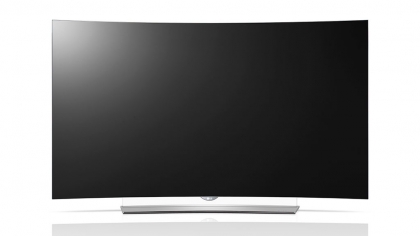
We liked
The EG960T’s self-lighting pixels are mind-blowing, providing perfect blacks, bright, pure whites and stunningly vibrant images.
While the TV’s picture quality looks best when displaying 4K content, detail is still wonderful with upscaled 1080p content. And while the EG960T’s pixels may look fantastic when displaying bright, colourful imagery, they truly shine (in a figurative sense) when they’re switched off completely, giving us unrivalled (and unbeatable) black levels.
You’ve heard of ludicrously high contrast ratio numbers in the past? Well, even they can’t beat infinite.
Its native 10-bit colour depth also makes the display capable of producing over a billion colours, making shading better than it has ever been before.
We disliked
While the TV’s curved display is much more subtle that competing 4K sets, we do wish that completely flat option was available to purchase. The curve wasn’t too bothersome here, but we’re still not entirely sold on the need for a curve at all.
We also wish that a few more HDMI ports had been included, to truly future-proof this set.
Finally, the combination of OLED and 4K technologies on large screens has made purchasing an EG960T a costly endeavour. Chances are, some of you will want to wait a while before picking one up.
Final Verdict
There’s no other way to put this: EG960T is hands-down the best television currently on the market.
It uses those self-lighting pixels exceptionally well, achieving outstanding images where light becomes a magical medium – can we praise it any higher?
Motion artefacts are few when watching the fluid action sequences, with film judder forgotten, too.
However, what we liked most about the EG960T was its equal treatment of various different sources. Native 4K footage from Netflix 4K looks stunning, of course, but so do Blu-ray discs and HDTV channels. Black levels and viewing angles, in particular, are light years ahead of anything else on the market.
And while price will obviously be an issue for many people, when you consider that the EG960T includes both OLED and 4K (which are still new technologies that are expensive to produce, especially at these screen sizes) and boasts market-leading specs, the price doesn’t seem so exorbitant.
Yes, there’s no denying that LG’s EG960T will cost you a hefty chunk of change, but if you have the money to spend, you’re not going to find a better TV at the moment – this is the current pinnacle in televisions.
![]()
Related Posts
December 6, 2021
7+ Web Design Trends for 2022: Which Will You Use?
December 6, 2021
The 10 Best WordPress Booking Plugins to Use On Your Website
December 6, 2021
How to Use a Web Cache Viewer to View a Cached Page
November 6, 2021
10 Modern Web Design Trends for 2022
November 6, 2021
Best Free SSL Certificate Providers (+ How to Get Started)
November 6, 2021
How to Design a Landing Page That Sends Conversions Skyrocketing
November 6, 2021
What Are the Best WordPress Security Plugins for your Website?
October 6, 2021
Your Guide to How to Buy a Domain Name
October 6, 2021
How to Build a WordPress Website: 9 Steps to Build Your Site
September 6, 2021
10 Best Websites for Downloading Free PSD Files
September 6, 2021
HTML5 Template: A Basic Code Template to Start Your Next Project
September 6, 2021
How Much Does It Cost to Build a Website for a Small Business?
September 6, 2021
A List of Free Public CDNs for Web Developers
September 6, 2021
6 Advanced JavaScript Concepts You Should Know
August 6, 2021
10 Simple Tips for Launching a Website
August 6, 2021
25 Beautiful Examples of “Coming Soon” Pages
August 6, 2021
10 Useful Responsive Design Testing Tools
August 6, 2021
Best-Converting Shopify Themes: 4 Best Shopify Themes
July 6, 2021
What Is Alt Text and Why Should You Use It?
July 6, 2021
24 Must-Know Graphic Design Terms
June 6, 2021
How to Design a Product Page: 6 Pro Design Tips
April 6, 2021
A Beginner’s Guide to Competitor Website Analysis
April 6, 2021
6 BigCommerce Design Tips For Big Ecommerce Results
April 6, 2021
Is WordPress Good for Ecommerce? [Pros and Cons]
March 6, 2021
Make Websites Mobile-Friendly: 5 Astounding Tips
March 6, 2021
Shopify vs. Magento: Which Platform Should I Use?
March 6, 2021
Top 5 Web Design Tools & Software Applications
February 6, 2021
Website Optimization Checklist: Your Go-To Guide to SEO
February 6, 2021
5 UX Design Trends to Dazzle Users in 2021
February 6, 2021
What Is the Average Page Load Time and How Can You Do Better?
February 6, 2021
Choosing an Ecommerce Platform That Will Wow Customers
February 6, 2021
7 Best Practices for Crafting Landing Pages with Forms
February 6, 2021
7 B2B Web Design Tips to Craft an Eye-Catching Website
January 6, 2021
Mobile-Friendly Checker | Check Your Site’s Mobile Score Now
January 6, 2021
8 Tips for Developing a Fantastic Mobile-Friendly Website
December 6, 2020
How to Add an Online Store to Your Website [4 Ways]
December 6, 2020
5 UX Design Tips for Seamless Online Shopping
November 6, 2020
Ecommerce Website Essentials: Does Your Site Have All 11?
November 6, 2020
5 Small Business Website Essentials You Need for Your Site
November 6, 2020
Your Website Redesign Checklist for 2020: 7 Steps for Success
May 1, 2020
Psychology of Color [Infographic]
April 21, 2020
How to start an online store that drives huge sales
January 3, 2020
5 Lead Generation Website Design Best Practices
March 6, 2019
6 Reasons You Should Redesign Your Website in 2019
March 6, 2019
7 Web Design Trends for 2019
February 19, 2019
Who owns the website/app source code, client or developer
February 7, 2019
Don’t Let Your Domain Names Expire in 2019
January 8, 2019
2019 Website Development Trends To Note
October 6, 2017
How Web Design Impacts Content Marketing
October 6, 2017
How to Choose a Navigation Setup
August 6, 2017
Why User Experience Matters to Marketing
July 6, 2017
5 Ways Web Design Impacts Customer Experience
September 6, 2016
How to Learn Angular
September 6, 2016
The Excuses for Not Having a Website (Infographic)
September 6, 2016
How to Build an Award-Winning Web Design Team
September 6, 2016
13 Free Data Visualization Tools
August 6, 2016
How Selling Pastries Helped Us Design a Better Product
August 6, 2016
11 Sites to Help You Find Material Design Inspiration
July 4, 2016
How to change free wordpress.com url
April 6, 2016
The 5 Best Free FTP Clients
April 6, 2016
7 Free UX E-Books Worth Reading
March 6, 2016
Can Handwritten Letters Get You More Clients?
December 10, 2015
Star Wars Week: How to create your own Star Wars effects for free
December 6, 2015
20 "Coming Soon" Pages for Inspiration
December 6, 2015
6 Free Tools for Creating Your Own Icon Font
December 6, 2015
9 Useful Tools for Creating Material Design Color Palettes
November 6, 2015
20 Free UI Kits to Download
November 6, 2015
50 Web Designs with Awesome Typography
November 6, 2015
When to Use rel="nofollow"
November 6, 2015
7 Free Books That Will Help You Become More Productive
November 6, 2015
50 Beautiful One-Page Websites for Inspiration
November 6, 2015
Circular Images with CSS
October 6, 2015
Lessons Learned from an Unsuccessful Kickstarter
October 6, 2015
5 Games That Teach You How to Code
October 6, 2015
Cheatsheet: Photoshop Keyboard Shortcuts
October 6, 2015
An Easy Way to Create a Freelance Contract for Your Projects
October 6, 2015
50 Design Agency Websites for Inspiration
September 29, 2015
JB Hi-Fi shutting the book on ebooks
September 24, 2015
Opinion: Quick, Quickflix: It's time to give yourself the flick
September 24, 2015
New Star Wars 360-degree video is among first on Facebook
September 21, 2015
Apple purges malicious iPhone and iPad apps from App Store
September 12, 2015
Apple's new Live Photos feature will eat up your storage
September 12, 2015
The latest Windows 10 Mobile preview has been delayed
September 12, 2015
IBM buys StrongLoop to add Node.js development to its cloud
September 8, 2015
Fake Android porn app takes your photo, then holds it ransom
September 6, 2015
50 Restaurant Websites for Inspiration
September 6, 2015
Zero UI — The Future of Interfaces
September 6, 2015
50 Beautiful Websites with Big Background Images
September 6, 2015
Infographic: 69 Web Design Tips
September 6, 2015
Free Windows 10 Icons
September 2, 2015
Instagram turns itself into a genuine messaging service
August 11, 2015
In Depth: How Microsoft taught Cortana to be more human
August 11, 2015
Windows 10 price, news and features
August 11, 2015
Windows 10's broken update introduces endless reboot loop
August 11, 2015
Windows 10 races to 27m installs
August 11, 2015
Windows 10 IoT Core gets first public release
August 10, 2015
iOS Tips: How to backup iPhone to an external drive
August 10, 2015
Windows 8.1 RT finally getting Windows 10 Start Menu
August 10, 2015
How to use Windows Hello
August 10, 2015
Review: Moto Surround
August 10, 2015
Review: Moto G (2015)
August 9, 2015
8 of the best free VPN services
August 8, 2015
Use Firefox? Mozilla urges you update ASAP
August 7, 2015
Mac Tips: Apple Mail: How to remove the Favorites Bar
August 7, 2015
How to make the OS X dock appear faster
August 7, 2015
Review: BQ Aquaris E45 Ubuntu Edition
August 7, 2015
Review: Acer Liquid Jade Z
August 6, 2015
How to reinstall Linux
August 6, 2015
How to reinstall Windows
August 6, 2015
Updated: Apple Music: release date, price and features
August 6, 2015
Social News Websites for Front-End Developers
August 6, 2015
10 Free JavaScript Books
August 6, 2015
50 Beautiful Blog Designs
August 6, 2015
Animated SVG Pipes Effect
August 6, 2015
Launching Your First App
August 5, 2015
Windows 10 goes freemium with paid apps
August 5, 2015
Updated: Week 1 with Windows 10
August 5, 2015
Mac Tips: How to manage Safari notifications on Mac
August 5, 2015
Microsoft Sway may kill the PowerPoint presentation
August 4, 2015
Microsoft gives Outlook on the web a new look
August 4, 2015
Mac OS X vulnerable to new zero-day attack
August 4, 2015
Windows 10 users warned of two scams
August 4, 2015
Microsoft's Docs.com is now available to everyone
August 3, 2015
Mac Tips: How to edit the Favorites sidebar on Mac
August 3, 2015
Updated: Windows 10 price, news and features
July 29, 2015
Review: HP ProDesk 405 G2
July 29, 2015
Hands-on review: HP Elite x2 1011
July 29, 2015
Hands-on review: Updated: Windows 10 Mobile
July 29, 2015
Review: Updated: Nvidia Shield Android TV
July 28, 2015
LIVE: Windows 10 launch: Live Blog!
July 28, 2015
How to prepare for your upgrade to Windows 10
July 28, 2015
Review: Updated: Windows 10
July 28, 2015
Review: Updated: HP Pro Tablet 608
July 28, 2015
Review: Heat Genius
July 28, 2015
Hands-on review: Moto X Play
July 28, 2015
Hands-on review: Moto X Style
July 28, 2015
Hands-on review: Moto G (2015)
July 28, 2015
Review: 13-inch MacBook Air (early 2015)
July 28, 2015
Hands-on review: OnePlus 2
July 28, 2015
Mac Tips: How to share printers on Mac
July 27, 2015
Apple Music's arrival hasn't opened Pandora's box
July 26, 2015
Review: Garmin Swim
July 25, 2015
How to merge OS X contacts into an existing list
July 25, 2015
Hands-on review: UPDATED: ZTE Axon
July 24, 2015
Mac Tips: How to zoom in on a Mac
July 24, 2015
What Windows 10 means for the enterprise
July 24, 2015
Review: JBL Charge 2 Plus
July 24, 2015
Review: Acer Aspire S7
July 24, 2015
Review: Updated: Canon G3 X
July 24, 2015
Review: Updated: iPad Air 2
July 24, 2015
Review: Thinksound On1
July 24, 2015
Review: Asus Chromebook Flip
July 24, 2015
Review: Garmin Forerunner 225
July 23, 2015
Review: Garmin nuvi 68LM
July 23, 2015
Review: Samsung Galaxy S6 Active
July 23, 2015
Review: Bowers and Wilkins P5 Wireless
July 23, 2015
Review: Dell XPS 15 (2015)
July 21, 2015
Review: Fuji S9900W
July 21, 2015
Review: Updated: Fitbit Surge
July 21, 2015
Review: UE Roll
July 21, 2015
Hands-on review: Ubik Uno
July 20, 2015
Review: Samsung HW-J650
July 20, 2015
Updated: 40 best Android Wear smartwatch apps 2015
July 20, 2015
Review: Acer Chromebook C740 review
July 20, 2015
Review: Huawei Talkband B2
July 20, 2015
Review: Dell Venue 10 7000
July 20, 2015
Review: Intel Core i7-5775C
July 17, 2015
Mac Tips: How to delete locked files on Mac
July 17, 2015
Review: Pebble Time
July 16, 2015
Microsoft just made Windows XP even less secure
July 16, 2015
Windows 8.1 RT is getting an update this September
July 16, 2015
OS showdown: Windows 10 vs Windows 8.1 vs Windows 7
July 16, 2015
Review: Acer CB280HK
July 15, 2015
Windows 10 is ready for new laptops and PCs
July 15, 2015
Explained: How to take a screenshot in Windows
July 15, 2015
Office for Windows 10 appears in latest build
July 14, 2015
Review: ZTE Axon
July 14, 2015
Review: ViewSonic VP2780-4K
July 14, 2015
Hands-on review: SanDisk Connect Wireless Stick
July 14, 2015
Review: Oppo PM-3
July 14, 2015
Review: BT 11ac Dual-Band Wi-Fi Extender 1200
July 14, 2015
Review: Fuji X-T10
July 13, 2015
How to build an SEO strategy for your business
July 13, 2015
Review: Lenovo ThinkPad Yoga 15
July 13, 2015
Review: Audio-Technica ATH-MSR7
July 13, 2015
Review: Garmin NuviCam LMT-D
July 13, 2015
Review: Dell Inspiron 13 7000
July 13, 2015
Hands-on review: AstroPi SenseHAT
July 13, 2015
Hands-on review: EE Rook
July 13, 2015
Hands-on review: Updated: HTC Vive
July 12, 2015
Here's the ultimate software list for PC fanatics
July 10, 2015
How to use the new Photos app for Mac
July 10, 2015
Windows 10 Insider Preview Build 10166 available now
July 10, 2015
Splunk spends big on cybersecurity acquisition
July 10, 2015
Making Windows 10 apps just got a whole lot easier
July 10, 2015
Review: Lenovo LaVie Z 360
July 9, 2015
OS X El Capitan public beta available right now
July 9, 2015
Microsoft finally unveils Office 2016 for Mac
July 9, 2015
Review: Updated: Chromecast
July 9, 2015
Review: Updated: Tesco Hudl 2
July 9, 2015
Review: Lenovo ThinkPad E550
July 9, 2015
Review: Updated: Google Nexus 6
July 8, 2015
What you need to know about Windows Server 2016
July 7, 2015
Microsoft to hike enterprise cloud pricing
July 6, 2015
Hacking Team end up being totally 0wned
July 6, 2015
Review: HP Pro Slate 12
July 6, 2015
Review: Samsung 850 Pro 2TB
July 6, 2015
Review: Asus RT-AC87U
July 6, 2015
Review: Jawbone UP2
July 6, 2015
Reimagining the Web Design Process
July 6, 2015
50 Clean Websites for Inspiration
July 6, 2015
15 Free Books for People Who Code
July 6, 2015
Web Storage: A Primer
July 6, 2015
A Look at Some CSS Methodologies
July 3, 2015
6 Essential Mac Mouse and Trackpad Tips
July 2, 2015
How to install a third party keyboard on Android
July 2, 2015
Review: UPDATED: Asus Zenfone 2
July 2, 2015
Review: Alienware 13
July 2, 2015
Review: HP DeskJet 1010
July 1, 2015
5 issues we want Apple Music to fix
June 13, 2015
Cortana will get its own button on Windows 10 PCs
June 12, 2015
Windows 10 will come with universal Skype app
June 12, 2015
iPad music production: 18 Best apps and gear
June 12, 2015
Windows 10 all set for early enterprise struggle
June 12, 2015
Review: Garmin VIRB Elite
June 11, 2015
Review: Updated: Nvidia Shield Tablet
June 11, 2015
Review: Nokia Lumia 635
June 10, 2015
Microsoft brings more online tweaks to Office 365
June 10, 2015
Mac Tips: How to use Screen Sharing in Mac OS X
June 9, 2015
Hands-on review: Meizu M2 Note
June 9, 2015
Hands-on review: EE 4GEE Action Camera
June 9, 2015
Review: Toshiba 3TB Canvio external hard drive
June 9, 2015
Review: Olympus SH-2
June 8, 2015
Hands-on review: Updated: Apple CarPlay
June 8, 2015
UPDATED: iOS 9 release date, features and news
June 8, 2015
Review: Updated: Roku 2
June 8, 2015
Review: Updated: PlayStation Vue
June 8, 2015
Review: Dell PowerEdge R730
June 8, 2015
Review: Canon SX710 HS
June 7, 2015
UPDATED: iOS 9 release date, features and rumors
June 7, 2015
Review: Lenovo S20-30
June 6, 2015
Free Writing Icons
June 6, 2015
15 CSS Questions to Test Your Knowledge
June 6, 2015
The Best CSS Reset Stylesheets
June 6, 2015
How CSS Specificity Works
June 5, 2015
'Delay' is a new feature in Windows 10
June 5, 2015
Review: Beyerdynamic Custom One Pro Plus
June 5, 2015
Latest SEO Marketing tools
June 5, 2015
Review: Nvidia Shield Android TV
June 5, 2015
Review: Honor 4X
June 5, 2015
Review: In Depth: Oppo R5
June 3, 2015
Hands-on review: Huawei P8 Lite
June 3, 2015
How To: How to create eBooks on a Mac
June 3, 2015
Review: Updated: Tidal
June 3, 2015
Review: Canon 750D (Rebel T6i)
June 2, 2015
Review: Updated: Asus ZenWatch
June 2, 2015
Review: Alcatel OneTouch Idol 3
June 2, 2015
Review: Updated: Nokia Lumia 1520
June 2, 2015
Review: Updated: Yotaphone 2
June 2, 2015
Review: Updated: Nokia Lumia 625
June 2, 2015
Review: Creative Muvo Mini
June 1, 2015
Review: Acer TravelMate P645 (2015)
June 1, 2015
Hands-on review: Corsair Bulldog
May 29, 2015
In Depth: NetApp: a requiem
May 29, 2015
July is looking definite for Windows 10 release
May 29, 2015
Hands-on review: Google Photos
May 28, 2015
Mac Tips: The 16 best free GarageBand plugins
May 28, 2015
Review: Canon 760D (Rebel T6s)
May 27, 2015
Review: Lenovo Yoga 3 14
May 27, 2015
Hands-on review: Serif Affinity Photo
May 27, 2015
Review: Garmin Vivoactive
May 26, 2015
Review: Datacolor Spyder5 Elite
May 26, 2015
Hands-on review: Sony Xperia Z3+
May 26, 2015
Review: Epson BrightLink Pro 1410Wi
May 26, 2015
Review: Technics Premium C700
May 26, 2015
Review: Canon EOS M3
May 26, 2015
Review: Updated: HTC One M9
May 26, 2015
Review: Updated: Sony Xperia Z3 Compact
May 25, 2015
Review: Updated: New Nintendo 3DS
May 25, 2015
Updated: 50 best Mac tips, tricks and timesavers
May 25, 2015
Updated: Windows email: 5 best free clients
May 25, 2015
Instagram is planning to invade your inbox
May 25, 2015
Review: Updated: Foxtel Play
May 24, 2015
How Windows 10 will change smartphones forever
May 24, 2015
Review: Vodafone Smart Prime 6
May 24, 2015
Review: Updated: iPad mini
May 22, 2015
Office Now may be Cortana for your work life
May 22, 2015
Review: Updated: Lenovo Yoga 3 Pro
May 22, 2015
Review: Microsoft Lumia 640 LTE
May 22, 2015
Review: Updated: Fitbit Flex
May 21, 2015
Updated: Best free Android apps 2015
May 21, 2015
Review: Asus ZenBook Pro UX501
May 21, 2015
Review: Sennheiser Momentum In-Ear
May 20, 2015
Hands-on review: UPDATED: Asus Zenfone 2
May 20, 2015
OS X 10.11 release date, features and rumors
May 18, 2015
Updated: Best free antivirus software 2015
May 18, 2015
iPhone 6S rumored to launch as soon as August
May 18, 2015
Microsoft ready to pounce and acquire IFS?
May 17, 2015
5 of the most popular Linux gaming distros
May 16, 2015
Review: Acer Chromebook 15 C910
May 16, 2015
Review: Lenovo ThinkPad X1 Carbon (2015)
May 16, 2015
Review: Polk Nue Voe
May 16, 2015
The top 10 data breaches of the past 12 months
May 16, 2015
Hands-on review: Updated: LG G4
May 16, 2015
Review: Updated: Quickflix
May 16, 2015
Review: LG Watch Urbane
May 16, 2015
Review: Razer Nabu X
May 16, 2015
Hands-on review: Updated: Windows 10
May 16, 2015
Review: UPDATED: Moto X
May 16, 2015
Review: Updated: Moto G (2013)
May 12, 2015
Review: TomTom Go 50
May 12, 2015
Review: Updated: Moto G (2014)
May 12, 2015
Review: Garmin Vivofit 2
May 12, 2015
Review: Asus Transformer Book Flip TP300LA
May 11, 2015
Review: MSI GT80 Titan
May 11, 2015
Review: Monster SuperStar BackFloat
May 9, 2015
Review: Updated: Apple Watch
May 7, 2015
5 million internet users infected by adware
May 7, 2015
Review: Updated: New MacBook 2015
May 6, 2015
Android M will be shown at Google IO 2015
May 6, 2015
Review: Epson WorkForce Pro WF-4630
May 6, 2015
Review: Master & Dynamic MH40
May 6, 2015
How to Use Gulp
May 6, 2015
Getting Started with Command-Line Interfaces
May 6, 2015
What It’s Like to Contribute to WordPress
May 6, 2015
Ultimate Guide to Link Types for Hyperlinks
May 6, 2015
11 Things You Might Not Know About jQuery
May 5, 2015
Hands-on review: Updated: PlayStation Now
May 5, 2015
Review: Lenovo ThinkPad Yoga 12
May 5, 2015
Review: Updated: iPad Air
May 5, 2015
Review: Panasonic SZ10
May 5, 2015
Review: Updated: Fetch TV
May 4, 2015
Review: Cambridge Audio Go V2
May 3, 2015
Review: Lightroom CC/Lightroom 6
May 2, 2015
5 of the most popular Raspberry Pi distros
May 1, 2015
Review: PlayStation Vue
May 1, 2015
Hands-on review: Updated: Microsoft HoloLens
April 30, 2015
Build 2015: Why Windows 10 may not arrive until fall
April 29, 2015
The biggest announcements from Microsoft Build 2015
April 29, 2015
Hands-on review: TomTom Bandit
April 29, 2015
Hands-on review: EE Harrier Mini
April 28, 2015
Review: Samsung NX500
April 28, 2015
Hands-on review: LG G4
April 28, 2015
Review: Patriot Ignite 480GB SSD
April 28, 2015
Hands-on review: EE Harrier
April 28, 2015
Review: Linx 10
April 28, 2015
Review: 1&1 Cloud Server
April 26, 2015
Hands-on review: Acer Iconia One 8
April 25, 2015
How to run Windows on a Mac with Boot Camp
April 24, 2015
Dropbox Notes poised to challenge Google Docs at launch
April 24, 2015
Hands-on review: Acer Aspire E14
April 24, 2015
Hands-on review: UPDATED: Valve Steam Controller
April 24, 2015
Review: Acer Iconia One 7
April 23, 2015
Windows 10 just revived everyone's favorite PC game
April 23, 2015
Google opens up Chromebooks to competitors
April 23, 2015
Here's how Outlook 2016 looks on Windows 10
April 23, 2015
Hands-on review: Updated: Acer Liquid M220
April 23, 2015
Hands-on review: Acer Aspire Switch 10 (2015)
April 23, 2015
Hands-on review: Acer Aspire R 11
April 22, 2015
Review: Alienware 17 (2015)
April 22, 2015
Hands-on review: Updated: HP Pavilion 15 (2015)
April 21, 2015
This is how Windows 10 will arrive on your PC
April 21, 2015
Review: iMac with Retina 5K display
April 21, 2015
Review: Epson XP-420 All-in-One
April 18, 2015
Google Now brings better search to Chrome OS
April 17, 2015
Review: Epson Moverio BT-200
April 17, 2015
Review: Pentax K-S2
April 16, 2015
Updated: Android Lollipop 5.0 update: when can I get it?
April 15, 2015
Hands-on review: Updated: Huawei P8
April 15, 2015
Review: SanDisk Ultra Dual USB Drive 3.0
April 15, 2015
Review: Updated: LG G3
April 15, 2015
Review: Updated: LG G3
April 15, 2015
Review: Crucial BX100 1TB
April 13, 2015
iOS 8.4 beta reveals complete Music app overhaul
April 13, 2015
Linux 4.0: little fanfare for a tiny new release
April 13, 2015
Achievement unlocked: Microsoft gamifies Windows 10
April 13, 2015
Best Android Wear smartwatch apps 2015
April 13, 2015
Review: Acer Aspire R13
April 12, 2015
Review: TP-Link Archer D9
April 10, 2015
Microsoft's new browser arrives for Windows 10 phones
April 10, 2015
Review: LG UltraWide 34UC97
April 9, 2015
Office now integrates with Dropbox on the web
April 9, 2015
Now you can buy video games with Apple Pay
April 9, 2015
Updated: iOS 8 features and updates
April 9, 2015
Microsoft's stripped down Nano Server is on the way
April 8, 2015
Skype Translator gets even more features
April 8, 2015
Windows mail services hit by widespread outages
April 8, 2015
Review: UPDATED: Amazon Echo
April 8, 2015
Hands-on review: Dell Venue 10 7000
April 8, 2015
Review: Updated: OS X 10.10 Yosemite
April 7, 2015
Google's GMeet could kill teleconferencing
April 7, 2015
Is Redstone the first Windows 10 update?
April 7, 2015
Next peek at Windows Server 2016 due next month
April 7, 2015
Review: Acer Aspire Switch 11
April 7, 2015
Review: Adobe Document Cloud
April 6, 2015
Hands-on review: Updated: New MacBook 2015
April 6, 2015
Freebie: 100 Awesome App Icons
April 6, 2015
Six Revisions Quarterly Report #1
April 6, 2015
A Modern Approach to Improving Website Speed
April 6, 2015
Disable Text Selection with CSS
April 4, 2015
Review: Nikon D7200
April 3, 2015
Amazon Prime video now streams to any Android tablet
April 3, 2015
Review: Google Cardboard
April 3, 2015
Review: MSI WS60
April 2, 2015
Chrome users can now run 1.3 million Android apps
April 2, 2015
See Windows 10 Mobile running on an Android handset
April 2, 2015
Review: Mini review: Macphun Noiseless Pro 1.0
April 2, 2015
Review: Intel SSD 750 Series 1.2TB
April 2, 2015
Review: BenQ TreVolo
April 2, 2015
Hands-on review: Nikon 1 J5
April 1, 2015
Microsoft launches Windows 10 music and video apps
April 1, 2015
Review: mini review: Sony XBA-H1
December 19, 2014
Review: CoPilot Premium sat nav app
December 19, 2014





























































































































































































































































































































































































































































































































































































